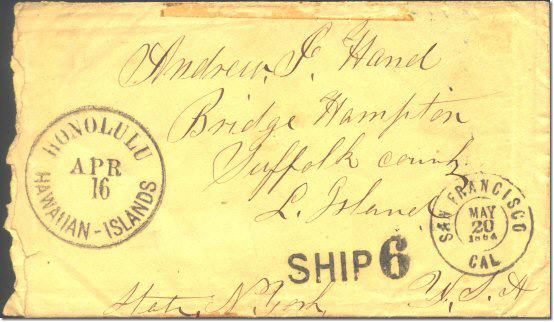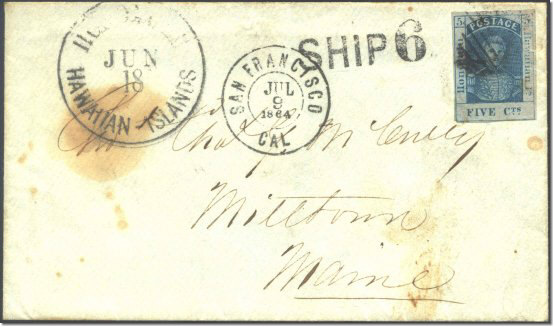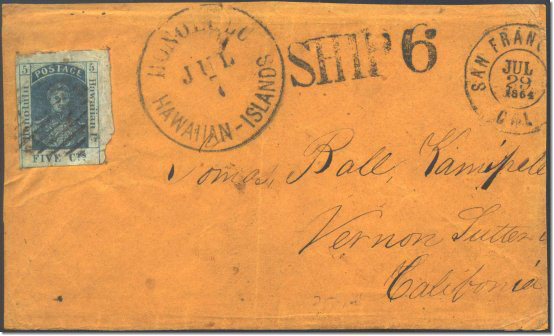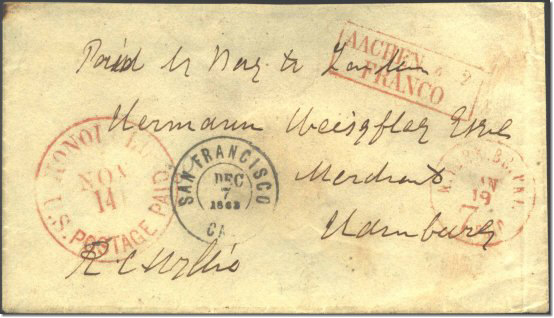::: First Sub-Period of the Late Treaty Period :::
|
|
 Back to Late Treaty Period.
Back to Late Treaty Period.
|
August 30, 1863-August 23, 1864
In this First Sub-Period, postage rates conformed to what we would expect to see - 3¢ per half ounce plus a 2¢
ship fee for a prepaid letter and double the United States rate (including the ship fee) for collect mail. Thus, a
half ounce letter cost 5¢ Hawaiian postage plus either 5¢ United States postage if prepaid or 6¢ United States
postage if sent collect.
Mail was carried primarily by sailing ship to San Francisco, with an occasional steamer taking mail. From San
Francisco, most mail was carried East by the overland coach via Salt Lake. Panama steamers continued to carry mail
as well, particularly during months when snow blocked the higher mountain elevations or the road was obstructed by
Indian hostilities. The First Sub-Period closed on August 24, 1864. That date is picked because it appears San
Francisco properly rated mail from Hawaii up to that date. The next sub-Periods involve an error rate imposed by
the United States.
Mail volume remained low during the Civil War in the United States. Only 44 covers are recorded in this First
Sub-Period. Of those, 18 were sent with United States postage unpaid, and 26 were sent prepaid. These numbers
reflect an increased tendency to send collect mail during the Civil War. One significant change is the decrease in
stampless covers, only 9 in this sub-Period, with only 1 of those prepaid, and 8 collect. Stampless covers
declined after 1860, when 49% of the surviving covers are stampless. In 1864, only 16% of the surviving covers are
stampless.
PREPAID MAIL TO THE UNITED STATES
|
|
|
Postmarked September 9 at Honolulu and September 25, 1863 at San Francisco, this letter was in the first mail
shipment under the new United States postage rates, carried by the American bark Comet, leaving Honolulu September
10, 1863 and arriving San Francisco September 24. The 5¢ United States stamp (US Scott No. 76), issued in 1863, is
seen on this repaired cover. The 5¢ stamp is recorded on fourteen covers in this sub-Period. Two covers are noted
with a United States 3¢ stamp (US Scott No. 65), two covers are noted with a United States 10¢ stamp (US Scott No.
68), and one cover is recorded with a United States 24¢ stamp (US Scott No. 70).
|

|
Here is another prepaid letter, postmarked July 11 with the incorrect Honolulu collect mail mark and July 14 with
the correct prepaid mark. This letter was carried to San Francisco on His Imperial Russian Majesty's Corvette
Calavala, leaving Honolulu July 14, 1864, and arriving San Francisco August 4, where it was postmarked August 5,
1864.
|
COLLECT MAIL TO THE UNITED STATES
|

|
A correctly rated collect letter postmarked April 16 at Honolulu and May 20, 1864 at San Francisco, with a SHIP 6
rate mark applied at San Francisco. Under the 1863 rate, collect mail from foreign countries was rated at double
the United States rate of 3¢ - in other words 6¢ - and no ship fee was added. As always, the 5¢ Hawaiian rate was
prepaid – in cash for this letter - so the full cost of a collect letter was 11¢, 5¢ paid by the sender, and 6¢
paid by the recipient.
|

|
Another collect letter is shown above. In this case, Hawaiian postage was paid by a 5¢ 1861 Boston Engraved stamp (Scott No. 9) instead of cash.
This cover was postmarked June 18, 1864, at Honolulu, and July 8, 1864, at San Francisco, where the SHIP 6 rate mark was applied. Scott No. 9 is
the Hawaiian stamp appearing most often in this Sub-Period. Fifty covers bearing Scott No. 9 are recorded in the
inventory. Of those covers, 17 were sent in this sub-Period. One cover bearing the 13¢ 1853
Boston Engraved stamp, Scott No. 6, also appears from this sub-Period, as shown in the inventory
of that stamp. No other Hawaiian stamp appears on a foreign cover in this sub-Period.
|
MAIL TO SAN FRANCISCO
With the 1863 postage rate changes in the United States came a drop rate of 2¢. Thus, any letter deposited in the
mail at San Francisco addressed to someone who lived in San Francisco cost 2¢, but only if prepaid with United
States stamps. On top of the drop rate was the 2¢ ship fee, so the full cost of a prepaid drop rate letter from
Hawaii to a San Francisco resident was 5¢ Hawaiian and 4¢ United States postage. No prepaid letters addressed for
delivery in San Francisco are recorded in this sub-Period.
A collect drop letter also cost 4¢ United States postage. This rate is achieved by doubling the 2¢ drop letter
rate but not adding the 2¢ ship fee. Under the 1863 law, collect letters from foreign countries were charged double
the ordinary postage and the ship fee was included. Some surviving collect covers in this sub-Period show they were
rated at 4¢ for double the drop rate. The following images show examples of collect mail charged only 4¢. Other
covers show a rate of 6¢ (See Advertiser Sale, lot 143 as an example), indicating confusion at San Francisco over
the proper rate. Please send me an E-mail (scott312@earthlink.net) if you have further
information on the rate for mail to San Francisco addressees under the United States 1863 rates.
|

|
Postmarked February 13 at Honolulu and March 8, 1864 at San Francisco, this collect cover was rated 4¢ at San
Francisco, to pay double the 2¢ drop rate. The American bark Young Hector carried this letter to San Francisco,
departing Honolulu February 13, 1864, and arriving San Francisco March 5.
|

|
Datelined Honolulu, December 14, 1863 and carried to San Francisco on the American bark Yankee, departing Honolulu
December 14, 1863 and arriving San Francisco January 3, 1864, where it was postmarked January 4 and rated DUE 4,
for a collect double drop rate. I have not unraveled the puzzle of why San Francisco was rating some incoming
collect mail from Hawaii at 4¢ and rating other incoming collect mail from Hawaii at 6¢.
|
MAIL TO INLAND CALIFORNIA
|

|
Postmarked July 7 at Honolulu and July 29, 1864 at San Francisco, this collect cover for inland California was
carried to San Francisco on the American bark Yankee, leaving Honolulu July 7, 1864 and arriving San Francisco
July 29. The letter was properly rated at 6¢, double the prepaid rate of 3¢, and without the ship fee added.
|
MAIL TO EUROPE
|

|
Postmarked November 14 at Honolulu and December 7, 1863 at San Francisco. This letter bears the notation "Paid
through to London" and the signature of Foreign Minister R. C. Wyllie. It was carried to San Francisco by the
American bark Comet, departing Honolulu November 14, 1863, and arriving San Francisco December 5, and
thence by overland coach via Salt Lake. At New York, it was postmarked January 19 with the British packet mark and
7 Paid.
|
|
|
Details of foreign mail markings on the Wyllie cover; to left the N.Y.PK.BR.MAIL postmark date January 19, 1864
with an integral 7PAID rate. On the right is the AACHEN 4 2/FRANCO mark for the Prussian closed mail. The numbers
4 and 2 indicate February 4.
A closed mail system was arranged between Hawaii and Great Britain. Letters carried in that mail were to have
Hawaii postage and the United States 2¢ ship fee prepaid. Recipients in Britain paid the international rate. Any
letters found with uncanceled stamps by the British mail agents aboard the Transatlantic steamships were required
to cancel the stamps. They did this using one of the canceling devices issued by the British Post Office. Hawaii
stamps with cancel A92 and A98 were used to prepay Hawaii postage and the ship fee on letters carried in the
closed mail bags.
|

|
The A92 and A98 cancel devices were issued by the Royal Post of England for use on mail ships operating in the
Atlantic. These markings were applied to letters carried in the closed mail to Britain. They are found on a
handful of Hawaiian stamps, suggesting an 1864 use. The A92 cancel seen here was used to cancel a stamp prepaying
the 2¢ ship fee for a letter carried in the closed mail bag.
|

|
The A98 cancel device used on a stamp prepaying Hawaii postage for a letter carried in the closed mail bag to
Great Britain.
|
|
|
 Back to Late Treaty Period.
Back to Late Treaty Period.
|
|

|
|
Copyright © 1999 - 2010 POST OFFICE IN PARADISE. All rights reserved.
|
|